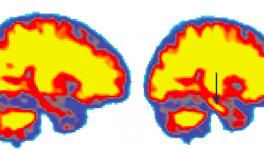Gender and the Brain: Why Neuroscience is Still Searching For Evidence
We call it 'the' brain. But is it a female or male brain?
If all you read is the top line on neuroscience into the gendered brain, you'll likely come away thinking that the brain is either male or female.
But some brain scientists argue that a lot of neurological research addressing the question of the brain's biological sex over the past 30 years has not been well-conducted.
Before we can even begin to argue the results of studies trying to find differences in the male and female brain, they say, we have to critically examine how those studies were facilitated in the first place.
The effect of brain size in gendered brain debate
There's one thing that almost all neuroscientists agree on and that is that the male brain is on average larger than the female brain. Scientists say this is because male bodies are on average larger than female bodies.
But that isn't always been considered in studies that look into the differences between male and female brains.
For example, many studies conducted over the past three decades seem to indicate that the male amygdala — which is involved in the processing of emotions associated with fear — is larger than the female amygdala.
But in a 2021 review of articles that were published in those 30 years, researcher Lise Eliot and her team found when they accounted for the fact that the female brain was smaller — in relative terms — than the male brain — there was almost no difference between the size of the female amygdala and the male amygdala.
That is, the average female amygdala was the same size as the average male amygdala relative to the average size of male and female bodies.
![]()
The amygdala is part of the brain's limbic system
The importance of controlling for brain size was demonstrated in a large 2018 study in which researchers at the University of Edinburgh in Scotland found that 85% of the differences in the brains of men and women became irrelevant when they accounted for the fact that male brains were on average larger than female brains. (But only because male bodies are on average bigger.)
Age complicates analysis of brains and the way they function
So lots of differences went away when scientists took the relative size of brains into account. But still, they said there was a difference about 15% between male and female brains.
Gina Rippon says that could be due to age. Rippon is a neurobiologist from Aston University in the UK who has focused much of her career on fighting what she calls "neurosexism" — gender bias in neurological studies.
The 2018 paper mentioned above used data from the UK Biobank, a large biomedical database that contains genetic and health information from about 500,000 people who live in Britain. The massive dataset is one of the first of its kind and has allowed for a number of breakthroughs in science.
But the Biobank only collects information from people over the age of 40 — that is, people who are considered to have been socialized to a specific gender through culture, Rippon says. And gender is considered by many scientists to be distinct from a person's biological sex — you are born, they say, with your biological sex but your gender is a social construct.
So, the Biobank is only able to provide a snapshot of people at a particular time in their lives. But the brain is plastic and malleable, changing as we experience new things, and that happens regardless of your biological sex.
"What they're trying to do is impossible," said Rippon when DW asked about scientists using the Biobank to track differences in the male and female brain.
Rippon wrote Gendered Brain: The New Neuroscience that Shatters the Myth of the Female Brain and is part of the Neurogenderings Network, an academic group that aims to critically examine how neuroscientific research is conducted when it comes to gender.
"Here's this amazing data set, which is fantastic. But it's generated more to look at physical illnesses [than gender issues]," said Rippon. "Whether or not it's so valuable when you're asking about social factors is questionable."
Researchers expect the UK Biobank data will eventually help scientists to understand how brain diseases of aging like Parkinson's and Alzheimers develop
Testing for the gendered brain in babies
In order to attempt to reconcile the problem of age and cultural conditioning, some scientists have tried to conduct comparative research on babies and apes — babies, because they haven't yet grown up in a gendered world, and apes, because they are neurologically similar to humans, but are not raised in the same sociocultural world as them.
A 2000 study conducted by a team led by Simon Baron-Cohen, a professor of developmental psychopathology at the University of Cambridge, tried to answer this "nature versus nurture" question by conducting an experiment on babies in the first 24 hours of their lives.
In the experiments, the researchers showed 102 infants a mobile toy and the lead researcher's face, in no specific order, and tracked how long the babies paid attention to the toy and the person.
They found that more of the boys paid longer attention to the mobile and that more of the girls paid longer attention to the person and their face.
The researchers said that their results showed male infants had a stronger preference for the "mechanical" object, while female infants had a stronger preference for the "social" object. They wrote that their findings "clearly demonstrate that sex differences are in part biological in origin."
But Rippon and other psychologists, such as the University of Melbourne's Cordelia Fine, argue that the study was flawed for a number of reasons, including the way that the babies were shown the mobile and the face.
Instead of showing the mobile and face at the same time to track which one the babies were drawn to more, the scientists showed them one at a time — and it's nearly impossible to expect that the lead researcher was able to maintain the exact same expression with every infant involved, said Fine.
"It is, I imagine, rather hard to hold up a mobile, and look at a newborn, in exactly the same way 102 times," wrote Fine wrote in her book Delusions of Gender.
"What if [the study's lead author] inadvertently moved the mobile more when she held it up for boys, or looked more directly, or with wider eyes, for the girls?" asked Fine.
Both Rippon and Fine cite that the study, which was conducted over two decades ago, has never been replicated. Scientists generally say that studies have to be replicated by independent groups of scientists to validate the results and conclusions — it is part of the peer review process.
Neurological studies are very difficult to conduct on babies because they have a hard time staying still long enough for researchers to capture images of their brains
Studying apes for the gendered brain
Researcher Robin Dunbar heads the Social and Evolutionary Neuroscience Research Group in the Department of Experimental Psychology at the University of Oxford. Dunbar primarily studies apes and told DW that biological gender does exist in young female and male apes.
Young female apes, Dunbar said, have been observed carrying sticks and logs around like they are babies, while young male apes are more inclined to take part in rough play. Dunbar said this provides evidence that the brain is also gendered even when it's not socially conditioned, such as our brains are in the human societies.
But here again Rippon argues that studies such as Dunbar's operate on false premises.
"Female baby apes are really powerfully socialized by their mothers to be mothers," said Rippon. "That's how they survive in the wild. They've got very specific roles."
So, is neuroscience sexist?
No study has yet been published that explains once and for all whether men and women are born different or merely conditioned to fit certain gender roles — and the studies referenced here are a snapshot of some of the complicated reasons why.
Edited by: Zulfikar Abbany
Get the latest reports & analysis with people's perspective on Protests, movements & deep analytical videos, discussions of the current affairs in your Telegram app. Subscribe to NewsClick's Telegram channel & get Real-Time updates on stories, as they get published on our website.


























